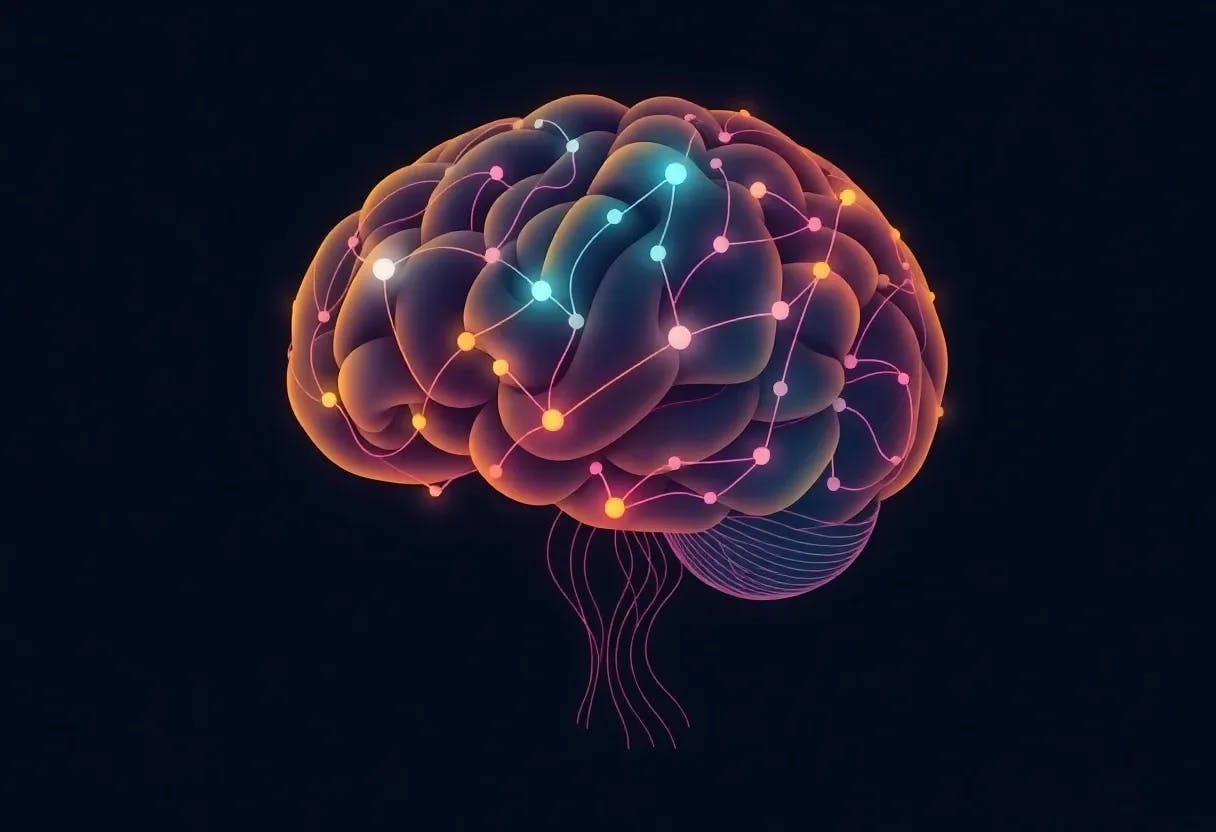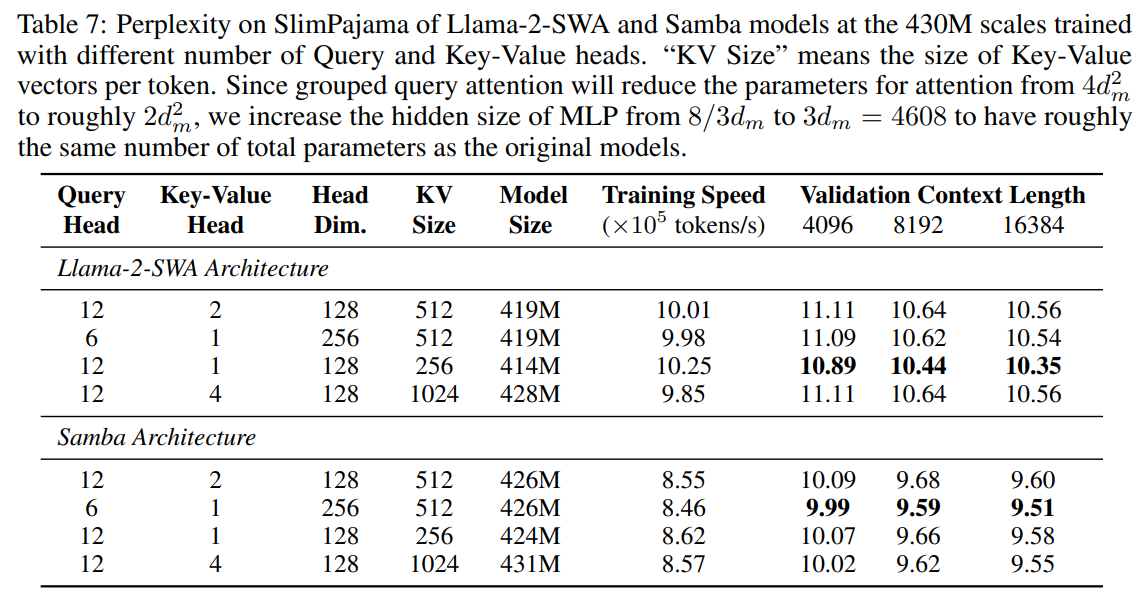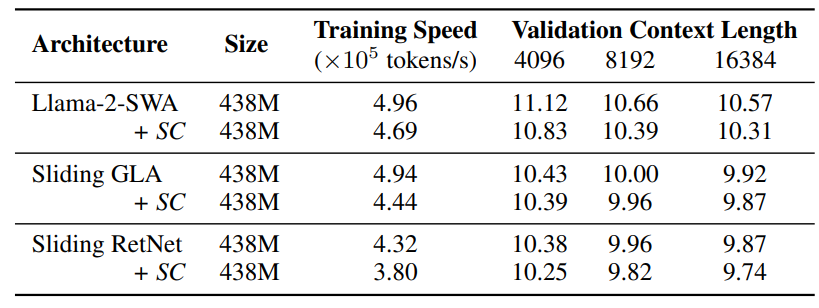Meet SAMBA: The AI Model That Remembers More and Trains Faster

Table of Links
Abstract and 1. Introduction
-
Methodology
-
Experiments and Results
3.1 Language Modeling on vQuality Data
3.2 Exploration on Attention and Linear Recurrence
3.3 Efficient Length Extrapolation
3.4 Long-Context Understanding
-
Analysis
-
Conclusion, Acknowledgement, and References
A. Implementation Details
B. Additional Experiment Results
C. Details of Entropy Measurement
D. Limitations
\
4 Analysis
In this section, we analyze the experimental results of SAMBA by answering the following research questions. The perplexity results on SlimPajama have a fluctuation around ±0.3%. Training speed is measured on 8×H100 GPUs by default. All the models in this section are trained on SlimPajama with 20B tokens and 4K sequence length, unless otherwise specified.
\
How to train models with Sliding Window Attention (SWA)? Since SWA has linear complexity with respect to the sequence length, it seems alluring to trade off the batch size to have a longer training sequence length without substantially decreasing the training throughput. However, as shown in Table 5, when the sequence length is increased, the validation perplexity also increases in all context lengths due to smaller batch sizes, and the optimal ratio of sequence length/window size observed is 2, resulting in a training length of 4096.
\

\
Why not hybridize with full attention? Some previous works [FDS+23, LLB+24] suggest a hybrid architecture of Mamba with full attention. However, as shown in Table 6, the extrapolation perplexity is exploding at a context length of 16k even if a single full attention layer is placed at the beginning of the model. Samba also has much better training throughput compared to Mamba-MLP alternatives because self-attention with the FlashAttention 2 implementation is more training efficient than Mamba when the sequence length is 4096.
\

\
How many parameters should be allocated to Attention? Given that Mamba can already capture low-rank information in the sequences through recurrent compression, the attention layers in Samba theoretically will only need to focus on information retrieval where a small number of attention heads should suffice. In Table 7, we explore the techniques of query head grouping [ALTdJ+23, Sha19], for both the Llama and Samba models. Surprisingly, both the Llama-2-SWA architecture and the Samba architecture show improved validation perplexity when there is only one key-value head. We conjecture that this is because small language models can be more easily optimized with fewer KV heads to pay attention to the contexts. We can also see that Samba has a 2× smaller optimal number of query heads than the SWA model, which confirms our hypothesis that Samba can support a smaller number of attention heads.
\

\
Why hybrid is better? We examine the entropy of the attention distributions for both the Samba 1.7B and the Mistral 1.6B models. As shown in Figure 5a, the Samba model has a larger variance of the attention entropy distributed over the layer indices, with an interesting pattern that the upper and lower layers have entropy higher than the middle layers. This may indicate that the attention layers are more specialized in the Samba architecture, with the middle layers focusing on precise retrieval with low-entropy attention, and the top and bottom layers focusing on integrating the global information through high-entropy attention. We can also see in Figure 5b that, compared to the Mamba-MLP model, Samba has a higher entropy of input selection probabilities in the middle layers. This indicates that, given the memory recalling ability of the attention layers, the Mamba layers can focus more on modeling the recurrent structure rather than performing retrieval with precise input selections. This kind of specialization can be beneficial for the downstream model performance, which may explain the impressive results from the Samba architecture. Details on how entropy is calculated are included in Appendix C.
\

\

\
Fair comparison between Mamba and other linear recurrent models? We can notice that the Short Convolution (SC) operator in Equation (1) is independent to the design of other parts of Mamba and can be applied to other linear recurrent models. As shown in Table 8, we explore the effect of SC on model performance through enhancing Llama-2-SWA, Sliding GLA, and Sliding RetNet with SC. Surprisingly, besides boosting the performance of RetNet, adding SC can also significantly improve the SWA’s performance, while the effect on GLA is less prominent. We think this is because GLA already has the fine-grained decays at the channel level, so the depthwise convolution doesn’t add much of the useful inductive bias for better modeling power. Notably, even with the SC enhancer, Sliding GLA and Sliding RetNet still fall short than the original Samba 421M’s performance shown in Table 3. This further justifies our choice of using Mamba for hybridization. We also find that adding SC to both the SWA and the linear attention layers in hybrid models produces negative results, and we leave it as a future work to understand the surprising effectiveness of SC in language modeling.
5 Conclusion
In this paper, we introduce SAMBA, a simple yet powerful hybrid neural architecture designed for efficient language modeling with unlimited context length. We show that SAMBA substantially outperforms state-of-the-art pure attention-based and SSM-based models across a wide range of benchmarks including common-sense reasoning, language understanding, mathematics and coding. Furthermore, SAMBA exhibits remarkable efficiency in processing long contexts, achieving substantial speedups in prompt processing and decoding throughput compared to the state-of-the-art Transformer architecture. The architecture’s ability to extrapolate memory recall to very long contexts (up to 256K) through minimal fine-tuning underscores its practical applicability for real-world tasks requiring extensive context understanding. This efficient long-term memorization ability is further demonstrated to be useful by our evaluations in downstream long-context summarization tasks. Our analyses also provide insight into the optimal training configurations for hybrid models and underscore the benefits of combining attention mechanisms with SSMs. We find that allocating fewer parameters to the attention mechanism while leveraging Mamba’s strengths for capturing recurrent structures leads to more efficient and effective language modeling. Our results suggest that SAMBA is a strong neural architecture for language modeling with unlimited context length.
Acknowledgement
We want to thank Shuohang Wang and Liyuan Liu for helping with the training infrastructure, Mojan Javaheripi and the team for the pre-training data, Ziyi Yang, Jianwen Zhang, Junheng Hao and the team for helping with post-training. The first author also wants to thank Songlin Yang for her Triton implementation of Mamba.
References
[AET+23] Simran Arora, Sabri Eyuboglu, Aman Timalsina, Isys Johnson, Michael Poli, James Zou, Atri Rudra, and Christopher Ré. Zoology: Measuring and improving recall in efficient language models. arXiv preprint arXiv: 2312.04927, 2023.\
[AEZ+24] Simran Arora, Sabri Eyuboglu, Michael Zhang, Aman Timalsina, Silas Alberti, Dylan Zinsley, James Zou, Atri Rudra, and Christopher Ré. Simple linear attention language models balance the recall-throughput tradeoff. arXiv preprint arXiv:2402.18668, 2024.
\
[AJA+24] Marah Abdin, Sam Ade Jacobs, Ammar Ahmad Awan, Jyoti Aneja, Ahmed Awadallah, Hany Awadalla, Nguyen Bach, Amit Bahree, Arash Bakhtiari, Harkirat Behl, Alon Benhaim, Misha Bilenko, Johan Bjorck, Sébastien Bubeck, Martin Cai, Caio César Teodoro Mendes, Weizhu Chen, Vishrav Chaudhary, Parul Chopra, Allie Del Giorno, Gustavo de Rosa, Matthew Dixon, Ronen Eldan, Dan Iter, Abhishek Goswami, Suriya Gunasekar, Emman Haider, Junheng Hao, Russell J. Hewett, Jamie Huynh, Mojan Javaheripi, Xin Jin, Piero Kauffmann, Nikos Karampatziakis, Dongwoo Kim, Mahoud Khademi, Lev Kurilenko, James R. Lee, Yin Tat Lee, Yuanzhi Li, Chen Liang, Weishung Liu, Eric Lin, Zeqi Lin, Piyush Madan, Arindam Mitra, Hardik Modi, Anh Nguyen, Brandon Norick, Barun Patra, Daniel Perez-Becker, Thomas Portet, Reid Pryzant, Heyang Qin, Marko Radmilac, Corby Rosset, Sambudha Roy, Olli Saarikivi, Amin Saied, Adil Salim, Michael Santacroce, Shital Shah, Ning Shang, Hiteshi Sharma, Xia Song, Olatunji Ruwase, Xin Wang, Rachel Ward, Guanhua Wang, Philipp Witte, Michael Wyatt, Can Xu, Jiahang Xu, Sonali Yadav, Fan Yang, Ziyi Yang, Donghan Yu, Chengruidong Zhang, Cyril Zhang, Jianwen Zhang, Li Lyna Zhang, Yi Zhang, Yunan Zhang, and Xiren Zhou. Phi-3 technical report: A highly capable language model locally on your phone. arXiv preprint arXiv: 2404.14219, 2024.
\
[ALTdJ+23] J. Ainslie, J. Lee-Thorp, Michiel de Jong, Yury Zemlyanskiy, Federico Lebr’on, and Sumit K. Sanghai. Gqa: Training generalized multi-query transformer models from multi-head checkpoints. Conference on Empirical Methods in Natural Language Processing, 2023.
\
[AON+21] Jacob Austin, Augustus Odena, Maxwell Nye, Maarten Bosma, Henryk Michalewski, David Dohan, Ellen Jiang, Carrie Cai, Michael Terry, Quoc Le, and Charles Sutton. Program synthesis with large language models. arXiv preprint arXiv: 2108.07732, 2021.
\
[BCB14] Dzmitry Bahdanau, Kyunghyun Cho, and Yoshua Bengio. Neural machine translation by jointly learning to align and translate. International Conference On Learning Representations, 2014.
\
[BCE+23] Sébastien Bubeck, Varun Chandrasekaran, Ronen Eldan, Johannes Gehrke, Eric Horvitz, Ece Kamar, Peter Lee, Yin Tat Lee, Yuanzhi Li, Scott Lundberg, Harsha Nori, Hamid Palangi, Marco Tulio Ribeiro, and Yi Zhang. Sparks of artificial general intelligence: Early experiments with gpt-4. arXiv preprint arXiv: 2303.12712, 2023.
\
[BDS+24] Aleksandar Botev, Soham De, Samuel L Smith, Anushan Fernando, George-Cristian Muraru, Ruba Haroun, Leonard Berrada, Razvan Pascanu, Pier Giuseppe Sessa, Robert Dadashi, Léonard Hussenot, Johan Ferret, Sertan Girgin, Olivier Bachem, Alek Andreev, Kathleen Kenealy, Thomas Mesnard, Cassidy Hardin, Surya Bhupatiraju, Shreya Pathak, Laurent Sifre, Morgane Rivière, Mihir Sanjay Kale, Juliette Love, Pouya Tafti, Armand Joulin, Noah Fiedel, Evan Senter, Yutian Chen, Srivatsan Srinivasan, Guillaume Desjardins, David Budden, Arnaud Doucet, Sharad Vikram, Adam Paszke, Trevor Gale, Sebastian Borgeaud, Charlie Chen, Andy Brock, Antonia Paterson, Jenny Brennan, Meg Risdal, Raj Gundluru, Nesh Devanathan, Paul Mooney, Nilay Chauhan, Phil Culliton, Luiz GUStavo Martins, Elisa Bandy, David Huntsperger, Glenn Cameron, Arthur Zucker, Tris Warkentin, Ludovic Peran, Minh Giang, Zoubin Ghahramani, Clément Farabet, Koray Kavukcuoglu, Demis Hassabis, Raia Hadsell, Yee Whye Teh, and Nando de Frietas. Recurrentgemma: Moving past transformers for efficient open language models. arXiv preprint arXiv: 2404.07839, 2024.
\
[BMR+20] Tom Brown, Benjamin Mann, Nick Ryder, Melanie Subbiah, Jared D Kaplan, Prafulla Dhariwal, Arvind Neelakantan, Pranav Shyam, Girish Sastry, Amanda Askell, et al. Language models are few-shot learners. Advances in neural information processing systems, 33:1877–1901, 2020.
\
[BPC20] Iz Beltagy, Matthew E. Peters, and Arman Cohan. Longformer: The long-document transformer. arXiv preprint arXiv: Arxiv-2004.05150, 2020.
\
[BZB+20] Yonatan Bisk, Rowan Zellers, Ronan Le Bras, Jianfeng Gao, and Yejin Choi. PIQA: reasoning about physical commonsense in natural language. In The Thirty-Fourth AAAI Conference on Artificial Intelligence, AAAI 2020, The Thirty-Second Innovative Applications of Artificial Intelligence Conference, IAAI 2020, The Tenth AAAI Symposium on Educational Advances in Artificial Intelligence, EAAI 2020, New York, NY, USA, February 7-12, 2020, pages 7432–7439. AAAI Press, 2020.
\
[CCE+18] Peter Clark, Isaac Cowhey, Oren Etzioni, Tushar Khot, Ashish Sabharwal, Carissa Schoenick, and Oyvind Tafjord. Think you have solved question answering? try arc, the ai2 reasoning challenge. arXiv preprint arXiv: 1803.05457, 2018.
\
[CKB+21] Karl Cobbe, Vineet Kosaraju, Mohammad Bavarian, Mark Chen, Heewoo Jun, Lukasz Kaiser, Matthias Plappert, Jerry Tworek, Jacob Hilton, Reiichiro Nakano, Christopher Hesse, and John Schulman. Training verifiers to solve math word problems. arXiv preprint arXiv: 2110.14168, 2021.
\
[CLC+19] Christopher Clark, Kenton Lee, Ming-Wei Chang, Tom Kwiatkowski, Michael Collins, and Kristina Toutanova. Boolq: Exploring the surprising difficulty of natural yes/no questions. In Jill Burstein, Christy Doran, and Thamar Solorio, editors, Proceedings of the 2019 Conference of the North American Chapter of the Association for Computational Linguistics: Human Language Technologies, NAACL-HLT 2019, Minneapolis, MN, USA, June 2-7, 2019, Volume 1 (Long and Short Papers), pages 2924–2936. Association for Computational Linguistics, 2019.
\
[CTJ+21] Mark Chen, Jerry Tworek, Heewoo Jun, Qiming Yuan, Henrique Ponde de Oliveira Pinto, Jared Kaplan, Harri Edwards, Yuri Burda, Nicholas Joseph, Greg Brockman, Alex Ray, Raul Puri, Gretchen Krueger, Michael Petrov, Heidy Khlaaf, Girish Sastry, Pamela Mishkin, Brooke Chan, Scott Gray, Nick Ryder, Mikhail Pavlov, Alethea Power, Lukasz Kaiser, Mohammad Bavarian, Clemens Winter, Philippe Tillet, Felipe Petroski Such, Dave Cummings, Matthias Plappert, Fotios Chantzis, Elizabeth Barnes, Ariel Herbert-Voss, William Hebgen Guss, Alex Nichol, Alex Paino, Nikolas Tezak, Jie Tang, Igor Babuschkin, Suchir Balaji, Shantanu Jain, William Saunders, Christopher Hesse, Andrew N. Carr, Jan Leike, Josh Achiam, Vedant Misra, Evan Morikawa, Alec Radford, Matthew Knight, Miles Brundage, Mira Murati, Katie Mayer, Peter Welinder, Bob McGrew, Dario Amodei, Sam McCandlish, Ilya Sutskever, and Wojciech Zaremba. Evaluating large language models trained on code. arXiv preprint arXiv: 2107.03374, 2021.
\
[CWCT23] Shouyuan Chen, Sherman Wong, Liangjian Chen, and Yuandong Tian. Extending context window of large language models via positional interpolation. arXiv preprint arXiv: 2306.15595, 2023.
\
[Dao23] Tri Dao. Flashattention-2: Faster attention with better parallelism and work partitioning. arXiv preprint arXiv: 2307.08691, 2023.
\
[DDH+22] Damai Dai, Li Dong, Yaru Hao, Zhifang Sui, Baobao Chang, and Furu Wei. Knowledge neurons in pretrained transformers. ACL, 2022.
\
[DFAG16] Y. Dauphin, Angela Fan, Michael Auli, and David Grangier. Language modeling with gated convolutional networks. International Conference On Machine Learning, 2016.
\
[DFE+22] Tri Dao, Daniel Y. Fu, Stefano Ermon, Atri Rudra, and Christopher Ré. FlashAttention: Fast and memory-efficient exact attention with IO-awareness. In Advances in Neural Information Processing Systems, 2022.
\
[EUD17] Stefan Elfwing, E. Uchibe, and K. Doya. Sigmoid-weighted linear units for neural network function approximation in reinforcement learning. Neural Networks, 2017.
\
[FDS+23] Daniel Y Fu, Tri Dao, Khaled Kamal Saab, Armin W Thomas, Atri Rudra, and Christopher Re. Hungry hungry hippos: Towards language modeling with state space models. In The Eleventh International Conference on Learning Representations, 2023.
\
[GD23] Albert Gu and Tri Dao. Mamba: Linear-time sequence modeling with selective state spaces. arXiv preprint arXiv:2312.00752, 2023.
\
[GGGR22] Albert Gu, Ankit Gupta, Karan Goel, and Christopher Ré. On the parameterization and initialization of diagonal state space models. ARXIV.ORG, 2022.
\
[GGR21] Albert Gu, Karan Goel, and Christopher R’e. Efficiently modeling long sequences with structured state spaces. International Conference On Learning Representations, 2021.
\
[HBB+21] Dan Hendrycks, Collin Burns, Steven Basart, Andy Zou, Mantas Mazeika, Dawn Song, and Jacob Steinhardt. Measuring massive multitask language understanding. In 9th International Conference on Learning Representations, ICLR 2021, Virtual Event, Austria, May 3-7, 2021. OpenReview.net, 2021.
\
[HBD+19] Ari Holtzman, Jan Buys, Li Du, Maxwell Forbes, and Yejin Choi. The curious case of neural text degeneration. International Conference on Learning Representations, 2019.
\
[HCP+21] Luyang Huang, Shuyang Cao, Nikolaus Parulian, Heng Ji, and Lu Wang. Efficient attentions for long document summarization. Proceedings of the 2021 Conference of the North American Chapter of the Association for Computational Linguistics: Human Language Technologies, pages 1419–1436, 2021.
\
[HQW+19] Yihui He, Jianing Qian, Jianren Wang, Cindy X. Le, Congrui Hetang, Qi Lyu, Wenping Wang, and Tianwei Yue. Depth-wise decomposition for accelerating separable convolutions in efficient convolutional neural networks. arXiv preprint arXiv: 1910.09455, 2019.
\
[HWX+23] Chi Han, Qifan Wang, Wenhan Xiong, Yu Chen, Heng Ji, and Sinong Wang. Lm-infinite: Simple on-the-fly length generalization for large language models. arXiv preprint arXiv: 2308.16137, 2023.
\
[HZRS16] Kaiming He, Xiangyu Zhang, Shaoqing Ren, and Jian Sun. Deep residual learning for image recognition. CVPR, 2016.
\
[JHY+24] Hongye Jin, Xiaotian Han, Jingfeng Yang, Zhimeng Jiang, Zirui Liu, Chia-Yuan Chang, Huiyuan Chen, and Xia Hu. Llm maybe longlm: Self-extend llm context window without tuning. arXiv preprint arXiv: 2401.01325, 2024.
\
[JSM+23] Albert Q. Jiang, Alexandre Sablayrolles, Arthur Mensch, Chris Bamford, Devendra Singh Chaplot, Diego de las Casas, Florian Bressand, Gianna Lengyel, Guillaume Lample, Lucile Saulnier, Lélio Renard Lavaud, Marie-Anne Lachaux, Pierre Stock, Teven Le Scao, Thibaut Lavril, Thomas Wang, Timothée Lacroix, and William El Sayed. Mistral 7b. arXiv preprint arXiv: 2310.06825, 2023.
\
[Kat23] Tobias Katsch. Gateloop: Fully data-controlled linear recurrence for sequence modeling. arXiv preprint arXiv: 2311.01927, 2023.
\
[LBE+23] Yuanzhi Li, Sébastien Bubeck, Ronen Eldan, Allie Del Giorno, Suriya Gunasekar, and Yin Tat Lee. Textbooks are all you need ii: phi-1.5 technical report. arXiv preprint arXiv: 2309.05463, 2023.
\
[LH18] Ilya Loshchilov and Frank Hutter. Decoupled weight decay regularization. In International Conference on Learning Representations, 2018.
\
[LHE22] Stephanie Lin, Jacob Hilton, and Owain Evans. TruthfulQA: Measuring how models mimic human falsehoods. In Smaranda Muresan, Preslav Nakov, and Aline Villavicencio, editors, Proceedings of the 60th Annual Meeting of the Association for Computational Linguistics (Volume 1: Long Papers), pages 3214–3252, Dublin, Ireland, may 2022. Association for Computational Linguistics.
\
[LLB+24] Opher Lieber, Barak Lenz, Hofit Bata, Gal Cohen, Jhonathan Osin, Itay Dalmedigos, Erez Safahi, Shaked Meirom, Yonatan Belinkov, Shai Shalev-Shwartz, Omri Abend, Raz Alon, Tomer Asida, Amir Bergman, Roman Glozman, Michael Gokhman, Avashalom Manevich, Nir Ratner, Noam Rozen, Erez Shwartz, Mor Zusman, and Yoav Shoham. Jamba: A hybrid transformer-mamba language model. arXiv preprint arXiv: 2403.19887, 2024.
\
[MCKS18] Todor Mihaylov, Peter Clark, Tushar Khot, and Ashish Sabharwal. Can a suit of armor conduct electricity? a new dataset for open book question answering. Conference on Empirical Methods in Natural Language Processing, 2018.
\
[Met24] MetaAI. Introducing meta llama 3: The most capable openly available llm to date, 2024. URL: https://ai.meta.com/blog/meta-llama-3/.
\
[MJ23] Amirkeivan Mohtashami and Martin Jaggi. Landmark attention: Random-access infinite context length for transformers. arXiv preprint arXiv: 2305.16300, 2023.
\
[MPS24] William Merrill, Jackson Petty, and Ashish Sabharwal. The illusion of state in state-space models. arXiv preprint arXiv: 2404.08819, 2024.
\
[MZK+23] Xuezhe Ma, Chunting Zhou, Xiang Kong, Junxian He, Liangke Gui, Graham Neubig, Jonathan May, and Luke Zettlemoyer. Mega: Moving average equipped gated attention. In The Eleventh International Conference on Learning Representations, 2023.
\
[Ope23] OpenAI. Gpt-4 technical report. PREPRINT, 2023.
\
[OSG+23] Antonio Orvieto, Samuel L. Smith, Albert Gu, Anushan Fernando, Caglar Gulcehre, Razvan Pascanu, and Soham De. Resurrecting recurrent neural networks for long sequences. International Conference on Machine Learning, 2023.
\
[PMN+23] Michael Poli, Stefano Massaroli, Eric Q. Nguyen, Daniel Y. Fu, Tri Dao, S. Baccus, Y. Bengio, Stefano Ermon, and Christopher Ré. Hyena hierarchy: Towards larger convolutional language models. International Conference On Machine Learning, 2023.
\
[PSL21] Ofir Press, Noah A. Smith, and M. Lewis. Train short, test long: Attention with linear biases enables input length extrapolation. International Conference On Learning Representations, 2021.
\
[QYS+24] Zhen Qin, Songlin Yang, Weixuan Sun, Xuyang Shen, Dong Li, Weigao Sun, and Yiran Zhong. Hgrn2: Gated linear rnns with state expansion. arXiv preprint arXiv: 2404.07904, 2024.
\
[QYZ23] Zhen Qin, Songlin Yang, and Yiran Zhong. Hierarchically gated recurrent neural network for sequence modeling. Neural Information Processing Systems, 2023. [RLW+23] Liliang Ren, Yang Liu, Shuohang Wang, Yichong Xu, Chenguang Zhu, and ChengXiang Zhai. Sparse modular activation for efficient sequence modeling. NEURIPS, 2023.
\
[RWC+19] Alec Radford, Jeff Wu, Rewon Child, David Luan, Dario Amodei, and Ilya Sutskever. Language models are unsupervised multitask learners. arXiv preprint, 2019.
\
[RZLL16] Pranav Rajpurkar, Jian Zhang, Konstantin Lopyrev, and Percy Liang. Squad: 100,000+ questions for machine comprehension of text. EMNLP, 2016.
\
[SAKM+23] Daria Soboleva, Faisal Al-Khateeb, Robert Myers, Jacob R Steeves, Joel Hestness, and Nolan Dey. Slimpajama: A 627b token cleaned and deduplicated version of redpajama, 2023. URL: https://www.cerebras.net/blog/ slimpajama-a-627b-token-cleaned-and-deduplicated-version-of-redpajama.
\
[SBBC21] Keisuke Sakaguchi, Ronan Le Bras, Chandra Bhagavatula, and Yejin Choi. Winogrande: An adversarial winograd schema challenge at scale. Communications of the ACM, 64(9):99–106, 2021.
\
[SDH+23] Yutao Sun, Li Dong, Shaohan Huang, Shuming Ma, Yuqing Xia, Jilong Xue, Jianyong Wang, and Furu Wei. Retentive network: A successor to transformer for large language models. arXiv preprint arXiv:2307.08621, 2023.
\
[Sha19] Noam Shazeer. Fast transformer decoding: One write-head is all you need. arXiv preprint arXiv: 1911.02150, 2019.
\
[Sha20] Noam Shazeer. Glu variants improve transformer. arXiv preprint arXiv: 2002.05202, 2020.
\
[SLP+21] Jianlin Su, Yu Lu, Shengfeng Pan, Ahmed Murtadha, Bo Wen, and Yunfeng Liu. Roformer: Enhanced transformer with rotary position embedding. arXiv preprint arXiv: 2104.09864, 2021.
\
[SRC+19] Maarten Sap, Hannah Rashkin, Derek Chen, Ronan LeBras, and Yejin Choi. Socialiqa: Commonsense reasoning about social interactions. arXiv preprint arXiv: 1904.09728, 2019.
\
[SWL23] Jimmy T.H. Smith, Andrew Warrington, and Scott Linderman. Simplified state space layers for sequence modeling. In The Eleventh International Conference on Learning Representations, 2023.
\
[Tea24] Gemma Team. Gemma: Open models based on gemini research and technology. arXiv preprint arXiv: 2403.08295, 2024.
\
[TMS+23] Hugo Touvron, Louis Martin, Kevin Stone, Peter Albert, Amjad Almahairi, Yasmine Babaei, Nikolay Bashlykov, Soumya Batra, Prajjwal Bhargava, Shruti Bhosale, Dan Bikel, Lukas Blecher, Cristian Canton Ferrer, Moya Chen, Guillem Cucurull, David Esiobu, Jude Fernandes, Jeremy Fu, Wenyin Fu, Brian Fuller, Cynthia Gao, Vedanuj Goswami, Naman Goyal, Anthony Hartshorn, Saghar Hosseini, Rui Hou, Hakan Inan, Marcin Kardas, Viktor Kerkez, Madian Khabsa, Isabel Kloumann, Artem Korenev, Punit Singh Koura, Marie-Anne Lachaux, Thibaut Lavril, Jenya Lee, Diana Liskovich, Yinghai Lu, Yuning Mao, Xavier Martinet, Todor Mihaylov, Pushkar Mishra, Igor Molybog, Yixin Nie, Andrew Poulton, Jeremy Reizenstein, Rashi Rungta, Kalyan Saladi, Alan Schelten, Ruan Silva, Eric Michael Smith, Ranjan Subramanian, Xiaoqing Ellen Tan, Binh Tang, Ross Taylor, Adina Williams, Jian Xiang Kuan, Puxin Xu, Zheng Yan, Iliyan Zarov, Yuchen Zhang, Angela Fan, Melanie Kambadur, Sharan Narang, Aurelien Rodriguez, Robert Stojnic, Sergey Edunov, and Thomas Scialom. Llama 2: Open foundation and fine-tuned chat models. arXiv preprint arXiv: 2307.09288, 2023.
\
[VSP+17] Ashish Vaswani, Noam M. Shazeer, Niki Parmar, Jakob Uszkoreit, Llion Jones, Aidan N. Gomez, Lukasz Kaiser, and Illia Polosukhin. Attention is all you need. NIPS, 2017.
\
[WDL24] Kaiyue Wen, Xingyu Dang, and Kaifeng Lyu. Rnns are not transformers (yet): The key bottleneck on in-context retrieval. arXiv preprint arXiv: 2402.18510, 2024.
\
[WPC+22] Alex Wang, Richard Yuanzhe Pang, Angelica Chen, Jason Phang, and Samuel R. Bowman. Squality: Building a long-document summarization dataset the hard way. Conference on Empirical Methods in Natural Language Processing, 2022.
\
[WWS+22] Jason Wei, Xuezhi Wang, Dale Schuurmans, Maarten Bosma, E. Chi, F. Xia, Quoc Le, and Denny Zhou. Chain-of-thought prompting elicits reasoning in large language models. Neural Information Processing Systems, 2022.
\
[XTC+23] Guangxuan Xiao, Yuandong Tian, Beidi Chen, Song Han, and Mike Lewis. Efficient streaming language models with attention sinks. arXiv preprint arXiv: 2309.17453, 2023.
\
[XYH+20] Ruibin Xiong, Yunchang Yang, Di He, Kai Zheng, Shuxin Zheng, Chen Xing, Huishuai Zhang, Yanyan Lan, Liwei Wang, and Tie-Yan Liu. On layer normalization in the transformer architecture. In Proceedings of the 37th International Conference on Machine Learning, ICML 2020, 13-18 July 2020, Virtual Event, volume 119 of Proceedings of Machine Learning Research, pages 10524–10533. PMLR, 2020.
\
[YWS+23] Songlin Yang, Bailin Wang, Yikang Shen, Rameswar Panda, and Yoon Kim. Gated linear attention transformers with hardware-efficient training. arXiv preprint arXiv:2312.06635, 2023.
\
[YZ24] Songlin Yang and Yu Zhang. Fla: A triton-based library for hardware-efficient implementations of linear attention mechanism, January 2024.
\
[ZAP22] Edward Ayers Zhangir Azerbayev and Bartosz Piotrowski. Proof-pile, 2022. URL: https: //github.com/zhangir-azerbayev/proof-pile.
\
[ZHB+19] Rowan Zellers, Ari Holtzman, Yonatan Bisk, Ali Farhadi, and Yejin Choi. Hellaswag: Can a machine really finish your sentence? Annual Meeting of the Association for Computational Linguistics, 2019.
\
[ZLJ+22] Simiao Zuo, Xiaodong Liu, Jian Jiao, Denis Charles, Eren Manavoglu, Tuo Zhao, and Jianfeng Gao. Efficient long sequence modeling via state space augmented transformer. arXiv preprint arXiv: 2212.08136, 2022.
\
[ZS19] Biao Zhang and Rico Sennrich. Root mean square layer normalization. Neural Information Processing Systems, 2019.
\
[ZYL+15] Hao Zheng, Zhanlei Yang, Wenju Liu, Jizhong Liang, and Yanpeng Li. Improving deep neural networks using softplus units. 2015 International Joint Conference on Neural Networks (IJCNN), pages 1–4, 2015
\
:::info
Authors:
(1) Liliang Ren, Microsoft and University of Illinois at Urbana-Champaign (liliangren@microsoft.com);
(2) Yang Liu†, Microsoft (yaliu10@microsoft.com);
(3) Yadong Lu†, Microsoft (yadonglu@microsoft.com);
(4) Yelong Shen, Microsoft (yelong.shen@microsoft.com);
(5) Chen Liang, Microsoft (chenliang1@microsoft.com);
(6) Weizhu Chen, Microsoft (wzchen@microsoft.com).
:::
:::info
This paper is available on arxiv under CC BY 4.0 license.
:::
\





